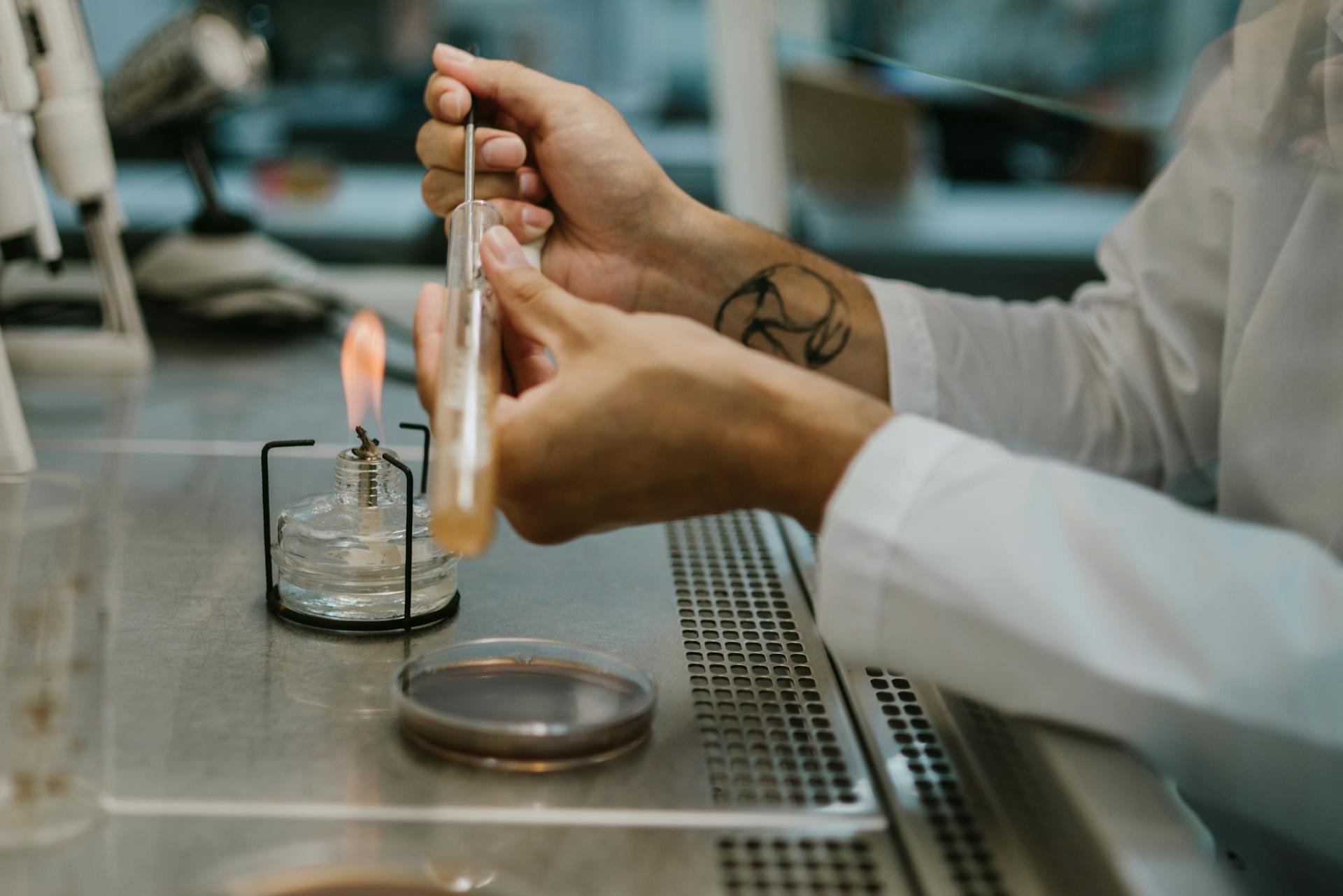
Welcoming a Lab Rott Mix puppy into your family is a thrilling experience, but it's essential to be prepared for the responsibilities that come with it. A Lab Rott Mix puppy can weigh between 70-120 pounds and reach 22-27 inches in height.
First-time puppy owners should know that their new furry friend will require regular exercise to stay healthy and happy. Aim for at least 30 minutes of physical activity per day, including walks and playtime.
Lab Rott Mix puppies need a balanced diet to support their growth and development. They require 2-3 cups of high-quality puppy food per day, divided into 3-4 meals until they're six months old.
Don't forget to schedule regular veterinary check-ups to ensure your puppy stays on track.
You might like: Pit Rott Lab Mix
Breed Information
Lab Rott mix puppies are a cross between a Labrador Retriever and a Rottweiler, making them a unique and intriguing breed.
Their size can vary, but they often grow to be medium to large in size, weighing between 65-115 pounds.
Lab Rott mix puppies are generally a mix of the two parent breeds' temperaments, but they can be prone to anxiety and stress if not properly socialized.
Their short coats require minimal grooming, making them a great choice for busy owners.
On a similar theme: Lab Shepherd Mix Size
What Am I Mixed With?
If you're unsure about your dog's breed mix, a DNA test can be a great way to get some answers. This will give you a good idea of what breeds went into your dog's genetic makeup.
Labrador mix bred dogs can often look very different from either of their parents.
To know with reasonable certainty where your mixed breed dog came from, you'll need to order a DNA test. This will give you as many as three or four generations back, and provide a clear picture of what breeds are in your dog's background.
A DNA test can also help if you're rescuing an older dog, as it's often the only way to determine the parentage of a mixed breed dog.
Curious to learn more? Check out: Carolina Lab Mix
Rottweiler Mix
If you're considering a Rottweiler mix, you'll want to know that they need plenty of exercise to stay physically fit and mentally happy.
Labrotties, a mix of Labrador Retriever and Rottweiler, are smart and quick to learn, but they do require early training and socialization.
These dogs can be distrustful of strangers and may not tolerate the attentions or teasing of small children, so it's essential to socialize them well.
Their short coat sheds moderately, so you'll need to groom them once a week to keep it in good condition and get rid of loose and dead hair.
With regular exercise and proper training, a Rottweiler mix can make a wonderful companion, but it's crucial to be aware of their potential temperament and grooming needs.
History
The Rottador breed has a fascinating history. Designer breeders started creating Rottadors in the 1990s by intentionally mixing Rottweilers and Labradors in North America.
Breeders aimed to minimize health problems common in purebred dogs and create a loyal family companion and watchdog. This goal led to the creation of Rottadors as demand for the mixed breed pups grew.
Some Rottadors have ended up in shelters or in the care of rescue groups. If you're considering bringing a Rottador into your family, consider adoption. You can check local shelters, Rottador rescues, or breed-specific Rottweiler and Labrador rescues, which sometimes help rehome mixed breeds.
Here are some registries that recognize the Rottador breed:
- ACHC = American Canine Hybrid Club
- DBR = Designer Breed Registry
- DDKC = Designer Dogs Kennel Club
- DRA = Dog Registry of America, Inc.
- IDCR = International Designer Canine Registry
Temperament and Personality
Lab Rott Mix puppies can inherit a wonderful temperament from their parents. Their mixed breed lineage can result in a unique combination of their Rottweiler and Labrador Retriever parents' temperaments.
Lab Rott Mix puppies are highly trainable, thriving on positive reinforcement. They're not suitable for homes with allergy sufferers due to their coat type.
They're naturally protective of their family and may be aloof with strangers, but once they befriend you, they're loyal companions. To ensure a smooth transition, meet both parents to assess their confidence and friendliness.
Here are some key temperament traits to expect from your Lab Rott Mix:
- Natural protectors of their family
- May be aloof with strangers
- Loyal companions once they befriend you
- Highly trainable with positive reinforcement
Keep in mind that Rottadors are prone to weight gain, so make sure to provide regular exercise, such as a daily one-hour walk.
Springador
Springadors are a cross between Springer Spaniels and Labs, known for being lively dogs with a high prey and hunting drive.
They benefit from positive reinforcement training from an early age to manage their energetic nature.
Springadors can have great temperaments, but some working lines may have nervous aggression problems and fixations on light chasing.
Make sure to meet the Springer parent to ensure they are confident and not agitated before considering bringing a Springador into your family.
English Springer Spaniels tend to be smaller and lighter than Labs, with a longer coat, while Springadors often have shorter coats and a shaggy appearance.
Temperament and Personality
Temperament and personality are crucial aspects of a dog's character, and Rottadors are no exception. Their temperament will be a product of their varying lineage, which can make them a unique and lovable companion.
Their parents' temperaments play a significant role in shaping their personality. If both parents are confident and friendly, the chances are good that your puppy will be the same. Meeting both parents is essential to ensure they have the right temperament for you and your family.
Rottadors make excellent family companions, being affectionate and protective in nature. They'll alert you when strangers approach, but once they befriend you, you have a friend for life. With proper training and socialization, they can thrive in a family environment.
A fresh viewpoint: Lab Shar Pei Mix Temperament
Rottadors are highly trainable, and they thrive on positive reinforcement. However, they can easily become bored, depressed, and frustrated if left alone for long periods, leading to unwanted behaviors. Make sure to devote plenty of time and attention to your Rottador.
Here are some key traits to keep in mind when considering a Rottador's temperament:
- Confident and friendly temperament, if inherited from their parents
- Affectionate and protective nature
- Highly trainable, but requires positive reinforcement
- Prone to boredom, depression, and frustration if left alone for long periods
Care and Needs
Your Lab Rott mix puppy needs regular veterinary checkups to detect any health concerns early, so schedule those appointments right away.
Rottadors are prone to weight gain, so be sure to give your puppy at least an hour-long walk per day to keep them active and healthy.
Daily ear checks are a must, and your vet will tell you how to clean them properly. Don't forget to trim those nails before they get too long!
Brush your puppy's teeth three times a week minimum, or daily if you want to be extra careful, to keep their oral health in top shape.
Return the revised heading

Rottweilers can grow up to 27 inches tall, with big heads, deep chests, and well-muscled bodies. They are powerful dogs that need commitment to positive training from day one.
Labrotties are a mix of Rottweilers and Labradors, and their temperament can be unpredictable. It's essential to socialize them well to ensure they behave well in their homes.
Rottweilers are a guarding breed, extremely loyal to their family but wary of strangers. They need regular positive contact with people of every age.
Your Labrottie puppy needs to be socialized regularly, just as you would with a pure guarding breed dog. Make sure they're familiar with things like beards, hats, and unusual items of clothing.
Health Needs
Regular veterinary checkups are crucial to detect any health concerns early, so schedule them for your Rottador as soon as possible.
Rottadors are prone to weight gain, so make sure your dog gets at least one hour-long walk per day to keep them healthy and happy.

Daily ear checks are a must to prevent debris and pests from building up, and your vet can advise on the best way to clean them.
Trim your Rottador's nails before they get too long, usually once or twice a month, to prevent clicking against the floor.
Maintaining oral health is a top priority for Rottadors, so brush their teeth three times a week minimum, or daily if possible, and follow your vet's instructions on proper brushing technique.
Rottadors are natural chewers, so keep sturdy toys available at all times to save your couch and other household items.
Crate and kennel training can help prevent destructive behavior when you're not home, so start training your puppy early on.
Some Rottadors may be prone to health issues like those seen in Rottweilers and Labrador Retrievers, so regular checkups are even more important.
If you're considering getting a Rottador from a breeder, make sure they've health tested the parents of your puppy to minimize the risk of inherited health problems.
A good breeder will have done eye tests, PRA clearances, and hip scores on the parents, so ask to see these results before making a decision.
Ultimately, the key to a healthy Rottador is regular care, attention, and checkups – so don't neglect these important responsibilities.
Exercise Needs
Exercise is essential for overall health and well-being. Regular physical activity can help improve mood, reduce stress, and increase energy levels.
Aim for at least 150 minutes of moderate-intensity aerobic exercise or 75 minutes of vigorous-intensity aerobic exercise per week. This can be broken down into 30 minutes per day, five days a week.
Strength training exercises, such as weightlifting or bodyweight exercises, can help build muscle and improve bone density. Aim for two to three strength training sessions per week.
Flexibility and stretching exercises can help improve range of motion and reduce muscle soreness. Incorporate activities like yoga or Pilates into your routine.
Incorporating physical activity into daily life can be as simple as taking the stairs instead of the elevator or walking to work. Every bit counts!
Size
The Rottador is a big dog, and you can expect them to be on the large side. Most Rottadors weigh in at 70 to 115 pounds.
Their height ranges from 24 to 27 inches at the shoulder, but some can be smaller or larger.
Coat and Grooming

Lab Rott mix puppies have beautiful coats that are often a mix of their Rottweiler and Labrador Retriever parents' coats and colors.
Their coats can be solid or a mix of black, brown, and grey colors. They usually have medium-to-short, dense coats.
A good brushing per week will probably do the job for their coat care. Bathing is recommended every few months with a mild shampoo.
Too much bathing can strip the coat of its natural oils.
All-Around Friendliness
Lab rott mix puppies are known for their friendly nature, which makes them excellent family pets. They inherit the friendly temperament of both Labradors and Rottweilers.
Their outgoing personalities mean they get along well with people and other animals, especially if socialized from an early age. This is crucial for a smooth household dynamic.
Their intelligence and loyalty also make them excellent companions for families with children. They are quick to form close bonds with their family members.

As a result, Lab rott mix puppies require plenty of attention and interaction to prevent boredom and destructive behavior. Regular exercise and mental stimulation are essential.
Their friendly nature also means they are naturally inclined to be protective of their family, but this can be balanced with proper training and socialization.
Frequently Asked Questions
Is a labrottie a good dog?
Labrotties make excellent family pets due to their friendly, protective, and affectionate nature. They can be a great addition to active families who want a loyal and loving companion.
Featured Images: pexels.com


